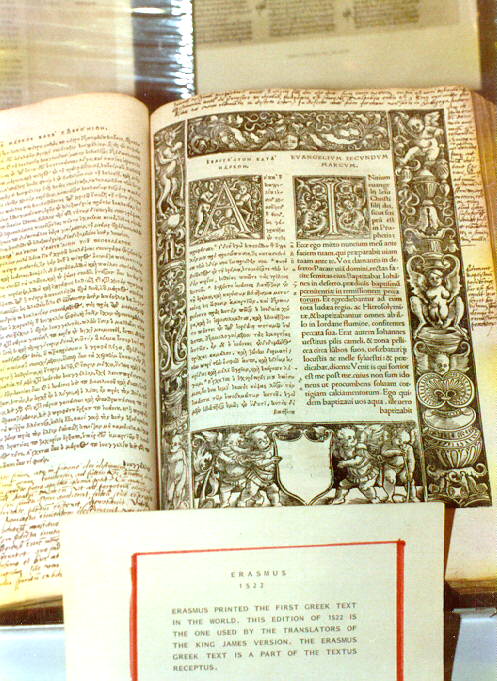|
**List: Latin Ministry
the Bible ( the Bible )
Latin...
"Latin enters history in the 6th century B.C., as
one of the three
primary languages of the Italian peninsula (with Umbrian and
Oscan). It was written in its own alphabet, derived from
Greek
character, and was soon to be elevated with the fortunes of the
forceful people of Rome. During the 1st century A.D. the
Roman Empire reached its greatest expansion, and with the
Empire went Latin, as administrative language and lingua franca.
When the foundations of Roman control crumbled in the 4th
and 5th centuries, Latin remained in use in many areas after the[db?]
the Roman forces had been withdrawn. Even after Romulus
Augustus had been deposed and the Roman Empire was no more,
and after the language of Italy had [chang]ed into what are now
known as Late Latin and Medieval
Italian, Latin was still used as
a literary tongue.
Throughout the Middle Ages, Latin remained the preferred
language of books, correspondence, and learned discourse. Its
continued popularity over any of the developing European
vernaculars is due primarily to its identification with the [Roman] Church,
which was then the center of European cultural and intellectual
life. At the end of the 16th century Latin began to wane, but it
was so well entrenched that it remained in considerable use until
the 18th century. It was still the tutorial language of the
Italian
universities in the 1800’s, but aside from the liturgical and ad-
ministrative affairs of the Roman Catholic Church and
a narrow-
ing circle of classical and theological scholars, Latin may now be
said to have passed out of use.
Liturgical, Church, or [Traditionalist], Latin (as opposed to Classical
Latin, the usage of the Roman Republic and early Empire) may
be regarded as a demotic form of Latin. This developed among
early converts to [professing] Christianity throughout the
Mediterranean
area. The new religion was spread by Hellenized Jews, and wor-
ship and Scriptures were at first in
Greek. However, the need to
present the Gospel in the language of
the growing community
of Latin-speaking converts resulted in the preparation of Scrip-
ture translations before the 3rd century. In fact, the unpolished,
even crude, language found in surviving remnants of the early
versions suggests that anyone who considered himself at all
qualified, dared to or felt compelled to translate the Scriptures.
These versions in ‘old Latin’ (or Vetus Latina, a term applied to
all Scriptures prepared prior to Jerome’s
translation) became so
numerous and divergent that Jerome lamented that
there were
as many different readings of passages as there were copies.
Accordingly, at the end of the 4th century, Jerome
began his
historic translation of the Bible." --1000 Tongues, 1972 [Info
only:
Heretick Jerome produced a corrupt Latin text.]
"St. Hieronymus, or
Jerome, has the honor of being the first
translator of the Bible known to us by name. Born about 340,
his long life spanned the transition in the Christian Church from
the release from imperial persecution and acknowledgment of
[nominal] Christianity as the Roman state
religion, to readjustment to the
changed world after the sack of Rome by the northern barbar-
ians. In some respects Jerome seems the most
modern of the
Church Fathers. His determination to live in the Holy Land and
learn Hebrew from Jewish scholars, in
order to understand the
Old Testament geographically and idiomatically, anticipates the
trends of Biblical scholarship associated with recent times.
Whereas, for the most part, the Old Latin versions had been
dependent upon the Greek Septuagint version
of the Old Testa-
ment, Jerome translated from the Hebrew text.
After years
spent on the revision of existing texts, Jerome undertook in the
evening of his life to prepare a fresh rendering of the Old Testa-
ment.
So popular did Jerome’s Vulgate (meaning
‘common’) [b]ible
become that in time it displaced the existing Old Latin
versions.
Although Old Latin versions continued to circulate
until the 9th
century (and were still being copied in the 11th century) it was
the Vulgate which eventually gained supremacy and was
to be
recognized as the official [b]ible of the [Roman] Church by
the Council of
Trent . The Vulgate served as the
Bible of the whole Western
Church for a millennium. It was thus the parent version of
all
those early pre-Reformation vernacular Scriptures, such as
Wycliffe’s in English, with which
the story of the Bible begins
in several European tongues." --1000 Tongues, 1972 [Info only]
"In this bibliography of Latin Bibles, only
publications that
present a new text, or are historically significant, are included.
Reprints are omitted."--1000 Tongues, 1972 [Info only]
|
"1460? Bible Mentelin, Strassburg
The ‘Strassburg Bible’, the first book printed in that city, but
of un-
certain date (not later than 1460). Other early editions
of the Bible
were printed in Strassburg in 1460 by W. Eggensteyn."--1000
Tongues, 1972 [Info only:
See German Bible History.]
|
"1516 New Testament (with
Greek)
Froben, Basel
The Latin translation of Desiderius
Erasmus. His Latin ‘paraphrases’
were first published in 1522."--1000 Tongues, 1972
[Info only:
ERASMUS’ N.T. "1516" Mark 1:2 both correct {col. #1 Greek
(προφήταις = prophets),
col. 2. Latin (prophetis = prophets)}.]
|
LATIN. ERASMUS'S VERSION.--The Bible of Every Land. (1860, Second
Edition) Samuel Bagster [Info only: n.d. John 1:14
correct (unigeniti = "only begotten").]
1519 Erasmus Greek Latin, https://www.bibles-online.net/1519/
"1517 Psalms Porrus, Genoa
The Latin Vulgate, as well as Latin translations of the
Hebrew and
Aramaic (Chaldee).
Other important Polyglot Psalters appeared in
1518 in Cologne and Basel."--1000 Tongues, 1972
[Info only:
See Arabic.]
|
- "The version of Munster was
published at Basle in 1534, and again in 1546: it is confined to
the Old Testament, and is held in some reputation on account of the clearness
of the
style, and its strict fidelity to the Hebrew text."--1860 S. Bagster
[Info only: Protestant.]
|
LATIN. MUNSTER'S VERSION.--1860 S. Bagster [Info
only: n.d. Exodus 15:1-13 unknown; used domino for Jehovah.]
"1535 Old Testament (with
Hebrew) Basel
A translation from the Hebrew by
Sebastian Münster."--1000 Tongues, 1972 [Info only:
SM, a Protestant reformer.]
|
- "The version of the Old and New Testaments
commenced by Leo Juda and completed by
Bibliander, professor of divinity at Zurich, was printed in 1543, and again
by Stephens
at Paris in 1545. In general accuracy and fidelity this version equals
that of Munster;
and the style, though less literal, is more elegant."--1860 S.
Bagster [Info only: Protestant.]
|
LATIN. LEO JUDA'S VERSION.--1860 S. Bagster [Info
only: n.d. Exodus 15:1-13 unknown; used DOMINO for Jehovah.]
"Zurich Version: Bible, Zurich,
1543; tr. by Leo
Juda, Theodorus Bibliander, Petrus Cholinus and Rudolphus
Gualtherus."--1000 Tongues, 1939 [Info only:
L. Juda, a Swiss Protestant reformer.]
|
"1543 Bible C. Froschauer, Zürich
The ‘Zürich Latin Bible’, translated by Leo Juda and,
later, by
Theodorus Bibliander. The N.T. was a revision of Erasmus by
Rudolf Gualter."--1000 Tongues, 1972 [Info only]
|
"1546 Pentateuch Strassburg
Translated from the Aramaic Targum
of Onkelos by P. Fagius."--1000 Tongues, 1972 [Info
only:
Fagius?]
|
"1551 Bible Oporinus, Basel
The Châteillon
French version, translated
into Classical, rather than
Ecclesiastical Latin, from the original languages. It was the first
‘independent’ version of the Latin Bible."--1000
Tongues, 1972 [Info only:
"tr. by Sebastien Châteillon."
per 1939]
|
"Bible: Novum Jesu Christi Testamentum; a
Sebastiano Castalione latine redditum. In usum scholarum. (Londini, Impensis
R. Ware, S. Birt, T. Longman, C. Hitch, J. Hodges, & J. Ward, 1750)"
[Info only]
http://catalog.hathitrust.org/Record/001932408
"First Latin Bible with
verse numbers; edited by Robert Stephanus; Paris, 1555: First Latin
Bible with verse divisions as in modern Bibles, J. Frellon, Lyons,
1555."--1000 Tongues, 1939 [Info only: ?]
|
LATIN. BEZA'S VERSION.--1860 S. Bagster [Info only:
n.d. John 1:14 correct (unigeniti = "only begotten").]
LATIN Beza’s version, 1557--1000 Tongues, 1939 [Info
only: "1911" John 3:14-20 TR.]
"1557 Bible R.
Stephanus, Geneva
The volume contained the Pagninus O.T. and the first
publication of
the N.T. text by Theodore Beza."--1000 Tongues,
1972 [Info only:
T. Beza, a French Protestant reformer.
He "renounced Catholicism at Geneva, 1548;" per CC.]
|
"1565 Bible J. Schwertel, Wittenberg
A revision of Paul Eberus, to bring the Latin text more into line with
the Luther German Bible."--
1000 Tongues, 1972 [Info only:
Paul Eber studied under Luther & Melanchthon per CC.]
|
"1569 New Testament H.
Stephanus, Geneva
A triglot, containing both the Vulgate text and a
Latin translation of
the Syriac version, by Immanuel Tremellius. This version
was in-
complete; the full translation appeared in 1627 and 1630."--1000
Tongues, 1972 [Info only: ?;
I. Tremellius, a converted Jew.]
|
"Tremellius and Junius
Version:
Old Testament, Frankfort, 1579; tr. by I. Tremellius and Franciscus
Junius (whose translation of the New Testament from
the Syraic had
been published in a polyglot of 1569); often printed with
Beza’s New
Testament."--1000 Tongues, 1939 [Info only]
|
- "The version of
Junius and Tremellius was published at Frankfort-on-the-Main in
1575-1579.
It was afterwards corrected by Junius, and on account of its close adherence
to the
Hebrew, the Old Testament of this
version has been frequently reprinted. The New
Testament, translated from the Syriac version by Tremellius, with Beza's translation
from the Greek, appeared in a
second edition at Geneva In 1590."--1860 S. Bagster [Info
only: Protesant.]
|
LATIN. JUNIUS AND TREMELLIUS'S VERSION.--The Bible of Every Land.
(1860, Second Edition) Samuel Bagster [Info only: n.d. Exodus
15:1-13 unknown; used Jehovæ & Jehova.]
"Toward the end of the 17th century
publications of Old Latin versions
and early Mss. for scholarly purposes began to appear."--1000
Tongues, 1972 [Info only: ?]
|
**File: Latin Bible History (3)--1860 S.
Bagster [Info only]
**File: Latin Critical Text History
|

